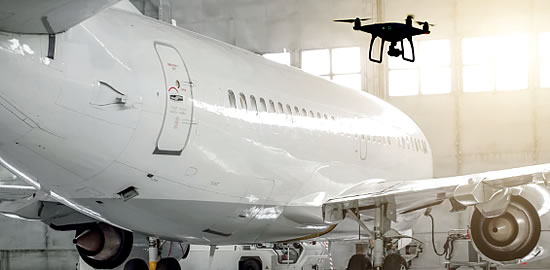AI, drones and sustainability in commercial aviation? We’ve done the talking, 2020 is a time for action
Graham Grose believes that 2020 heralds a time for action in three key areas if commercial aviation operators and MRO organisations are to keep pace in this competitive and evolving market landscape into the next decade.
While Artificial Intelligence (AI), drones and sustainability targets were virtually unheard of in the 1980s and 1990s, many of the aircraft and engines they will now be used to support were designed in that far off period and are still in operation today.
This is no time warp, this is reality and these technologies must be top of mind for commercial operators and MRO organisations to not only stay ahead of competition in this changing technological landscape, but to demonstrate they can deliver sustainably on their business objectives.
Complex, new generation aircraft has resulted in increased volumes of data for airline maintenance teams to manage. This large volume of information now being produced from engineering, manufacturing, operations and maintenance departments represents a challenge when it comes to manually generating specific work order tasks for technicians. This is where AI holds much promise to streamline operations, and will need to be reinforced by drone-supported inspections which have the potential to cover several maintenance tasks in significantly less time than technicians.
While maximising efficiencies and digitally evolving is not a new challenge for airlines and fleet operators, it must not be forgotten that using the latest technology to manage customer expectations needs to be balanced with meeting industry sustainability targets.
Here are three actions commercial aviation operators and MROs must take to get the balance right in 2020.
1. Adopt AI and ML - it will transform predictive maintenance strategies
Put simply, the goal for commercial airlines is to keep customers happy. This means ensuring flights remain on schedule and flight delays and cancellations are few and far between. But with the amount of aircraft airlines have within their fleets – as well as a huge variety of models – when hiccups occur, getting to the bottom of why can be like finding needles in haystacks. It is for this reason that integrating AI into predictive maintenance will be critical in the next 12 months and beyond.
For large-fleet commercial operators and aviation MRO providers alike, AI is now an essential tool. AI technology is expanding as a decision-making tool in the form of intelligent agents for data modelling and simulation. This means the arduous task of ingesting, aggregating and analysing raw data transmitted from aircraft is being shortened thanks to this increased digitisation.
Recent examples of airlines such as Delta and MROs such as Lufthansa Industry Solutions working on adopting AI and machine learning (ML) into their aircraft maintenance strategies highlight the transition organisations are already making towards digital and predictive-focused maintenance strategies. The reduced maintenance technician and engineering labour hours spent on aggregation and analysis of data makes these intelligent maintenance strategies particularly desirable.
At last year’s IFS World Conference, it was interesting to hear Rolls-Royce discuss its high expectations for the accuracy of its own predictive analytics strategy. The airline, which selected IFS Maintenix for exchanging engine data with airlines operating its Trent engines last year, targets a 100 percent success rate in terms of ensuring they never miss something they are looking for, at the same time as zero false predictions, which can be just as disruptive to its service.
Nick Ward, Head of OEM Digital Solutions, Rolls-Royce, explained, “We have a sophisticated simulation engine which looks across our entire fleet. It looks at all the risk drivers attached to engines within that fleet—things that might force the engine off the wing. We simulate those engines through their lives against different scenarios, different kinds of operating profiles that might be flown. We get a very accurate - greater than 90% accuracy - on exactly when any given engine is likely to be forced off wing.”

image: ifsworld.com
2. Stay alert to drone technology - it will soon be a part of daily MRO
Passenger drones are very much a longer-term concept in commercial aviation and we won’t be seeing commercial passengers transported by drones in 2020, but drone-supported inspections is a very real possibility.
Last year there were notable examples of aviation providers testing drone technology, including AAR who recently tested fully automated Donecle drone technology integration for inspections. This is an increasingly attractive prospect for commercial aviation operators because drones can conduct end-to-end visual inspections in under an hour—whereas manual inspections typically take up to six. One complete drone scan covers several maintenance tasks, and they are now being programmed to detect structural damage and assess paint quality, markings and signs of lightning strikes.
Barriers to the adoption of drone technology in inspections include certification and ensuring devices are stable enough to capture precise images. Laser technology will however help yield accurate images – onboard sensors can sense the drone’s environment and position the device with an accuracy down to centimetres – and if drones gain full certification for use in commercial aviation McKinsey projects the market could be a staggering $46 billion business segment by 2026.
. . . and help address the skills shortage
Drone technology will help organisations digitally transform and drive customer satisfaction, but its growing influence in operations also has the wider benefit of addressing the shortage of skilled maintenance technicians in the commercial aviation sector. It will be up to commercial aviation operators and MROs to keep pace with developments in drone-supported aviation this year to benefit from the time and labour resources that can be saved using this technology.
3. Sustainability targets must now be considered a priority
This year it is expected we will see record numbers of over 4.7 billion passengers scheduled to fly, a 137 percent increase from 2004, while the International Air Transport Association (IATA) predicts passenger numbers could reach over eight billion by 2037. But one of the biggest challenges as a result of this growing desire to fly is the environmental impact this is having, and substantial solutions will be in demand to tackle emissions and help airlines reduce their carbon footprint.
CORSIA, a plan from the International Civil Aviation Organization (ICAO) to achieve carbon-neutral growth for aviation from 2020, highlights the increased focus on how our use of fossil fuels is shaping our future, while flygskam or “flight shaming”, a movement across Europe encouraging people to stop taking flights as a means of transport, is another example of the pressure on the industry to improve its green credentials. Sustainable aviation fuel (SAF) is already helping fuel some flights today - last year KLM committed itself for a 10-year period to the development and purchase of 75,000 tonnes of SAF a year- but production must dramatically increase if IATA is to achieve its aim of one billion passengers to have flown on a sustainable aviation fuel-blend flight by 2025.
Fleets made up of lighter, fully electrified aircraft may be some way off, but last year we did see the unveiling of a prototype of the first commercial all-electric passenger aircraft in the form “Alice”, designed and constructed by Israeli firm Eviation. Alice is set to enter service in 2022, but regional airline and IFS customer Cape Air’s “double-digit” order of the new aircraft technology demonstrates the shift airlines are now making to address climate change.
It will become more critical for carriers to implement a fleet renewal programme which sees older, gas-heavy jets replaced with newer, more fuel-efficient aircraft to achieve near-term sustainability targets. Route optimisation will also grow in importance for airlines—they will need to make every effort to ensure they are providing the most direct and fuel-efficient journeys possible for their customers.
Fail to prepare, prepare to fail
In some ways the next 12 months involve putting the building blocks in place for the increasingly technological and environmentally-conscious world of commercial aviation. While previously the use of AI in maintenance strategies, testing drone-supported aviation MRO and focusing on sustainable and efficient fleet strategies may have seemed like buzzwords for organisations to show they are progressive, these are actions that must be top of mind for airlines into the next decade.
| © BlueSky Business Aviation News Ltd 2008-2020 |



